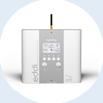Solar PV FAQ
What is Solar Photovoltaic (PV) power?
Photovoltaic (PV) systems use cells to convert solar radiation into electricity. A PV cell consists of two or more layers of a thin semiconducting material, usually silicon. Silicon is the second most abundant element (after oxygen) in the earth’s crust. When light shines on the cell it creates an electric field across these layers, causing electricity to flow. The greater the intensity of the light, the greater the flow of electricity. This electricity is conducted to an external circuit through metal contacts on the front and back of the cell. The electricity produced by a PV cell is direct current (DC), which means it must be converted to alternating current (AC) before it can be used to run most domestic or commercial appliances.
The voltage produced by a single PV cell is typically small (~0.5V for monocrystalline silicon), so several cells are interconnected to produce a module or panel with the desired peak voltage and current. Cells connected in series will give an additive voltage, while cells connected in parallel will produce higher currents. Modules are then linked and sized to provide the optimum output to meet a particular load (amount of electrical power required). The result is a PV array which supplies power to the building it is fitted on. If the building has mains electricity, any excess electricity can be exported to the national grid.
Alternatively, when demand is high, extra electricity can be purchased from the
national grid through the utility companies.
Where there is no mains supply, PV arrays can be used to charge batteries, potentially reducing or eliminating the need for diesel generators.
It is important that no part of the PV array experiences shading, as this can greatly affect its output.
A PV array has no moving parts, generates no noise and requires very little maintenance. It can be integrated onto existing structures and can be designed to have very little visual impact.
What are the different types of PV cell?
The three main types of solar cells are:
• Monocrystalline
• Polycrystalline
• Thin Film
Monocrystalline silicon is the traditional material for PV cells, with typical efficiencies of around 15%.
Monocrystalline cells are cut from a single large cylindrical crystal and are usually the most efficient type of PV cell. The manufacturing process is relatively complicated and expensive however, making it one of the most expensive of PV technologies. As time has gone on and the industry developed over the last few years however, monocrystalline has become the most common, pushing average efficiency of installed system up. The LG Solar modules we tend to install use monocrystalline cells, and the highest output modules boast efficiencies of 21.1%.
Polycrystalline silicon is formed from ingots of melted and re-crystallised silicon. This manufacturing process is simpler and cheaper than that of monocrystalline silicon, allowing the production of cheaper cells, but they are typically less efficient. Recent advances have succeeded in creating some polycrystalline cells that can match or even exceed the efficiency of monocrystalline PV cells.
Thin-film PV cells are a much less common technology in this context. Various different materials have been used, but all thin films require much less material than either mono or polycrystalline cells and are therefore cheaper to produce. This reduces the cost of the cells but also tends to reduce the efficiency. Some multi-layer thin films now have efficiencies comparable to crystalline PV cells.
What do I need in order for solar PV to work?
In order for your site or property to be suitable for a solar PV array, you will need an area of open roof or ground that is exposed to direct sunlight throughout as much of the day and as much of the year as possible. For best results, the panels should be south facing at a horizontal angle of 30-40 degrees, but in practice the panels can be faced between East and West and pitched between 10-50 degrees with little reduction in output. PV panels can be installed on flat or pitched roofs and a variety of mounting methods are available, depending on your
particular site.
Despite the UK’s reputation for lack of sunshine, solar PV performs well in this country and can even make significant contributions on cloudy and overcast days. Extensive testing and monitoring has shown that the annual output from solar PV is reasonably reliable, and should on average be around 800 kilowatt hours per kilowatt of installed capacity, assuming the panels are correctly sited and fully exposed.
The crucial factor when siting a PV array is that none of the panels experience shading and they are exposed to the sun for as long as possible. Remember that the sun will be lower in the sky during winter months than in summer months, and that this may increase the risk of shading in winter. Causes of shading can include trees, utility poles or neighbouring buildings. A 1kWp system would consist of around 4 panels (depending on size and rating) and occupy approximately 2.7m x 2.8m, depending on the mounting method and surface.
Will I be able to generate hot water?
The solar panels that we install are photovoltaic, which means they generate electricity and not hot water. Though this electricity could be used to heat water, for example with an electric immersion via a device like Eddi
01292 591 000
Or Request a Call Back:







